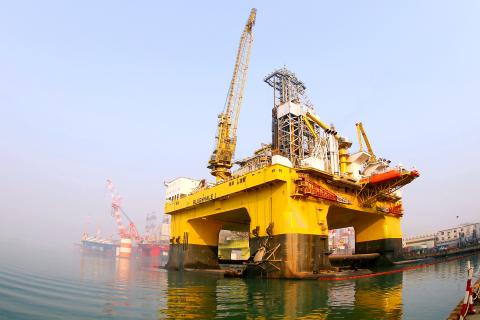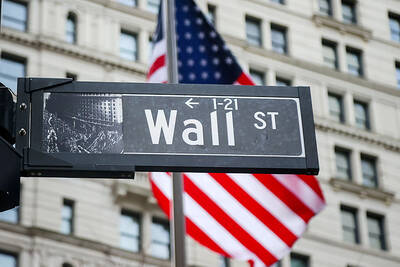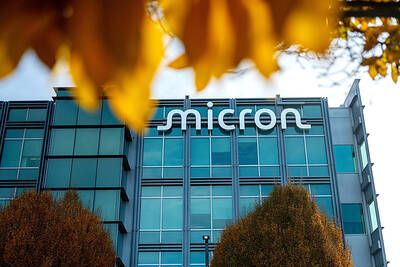China is drilling deep into the ocean floor in the hope of tapping vast deposits of a frozen fossil fuel known as “combustible ice,” but it would be years before it is part of the global energy mix.
Gas hydrates are found in the seabed as well as beneath permafrost, but experts say extracting methane from the ice crystals is technologically challenging and expensive.
Energy-guzzling China, one of several nations hoping to exploit the hard-to-reach resource to meet growing demand, announced a “historic breakthrough” in drilling tests in the South China Sea.

Photo: AFP
In six weeks, China extracted more than 235,000m3 of gas hydrate off the coast of Guangdong Province, a statement on the China Geological Survey’s Web site said.
“China has beaten expectations in completing the trial explorations of combustible ice using local innovations in technology and engineering,” Guangzhou Marine Geology Survey head Ye Jianliang (葉建良) said. “It marks a historic breakthrough.”
One cubic meter of gas hydrate, which is also known as “flammable ice” because methane can ignite, releases 164m3 of conventional natural gas once extracted, the US Department of Energy says.
Methane is extracted by heating or reducing the pressure inside the well to break down the hydrates.
Estimates for the size of the planet’s gas hydrate deposits vary widely, but the US department says it could exceed “the combined energy content of all other known fossil fuels.”
Analysts say the substantial resource could be a “game changer” for nations that have limited access to conventional natural gas.
“The perfect example is Japan because they don’t have much conventional gas and for them it could be an important reserve,” University of Auckland senior lecturer of geophysics Ingo Pecher said.
Japan is heavily reliant on liquefied natural gas imports, with most of the nation’s fleet of nuclear reactors still offline more than six years after the 2011 tsunami disaster at Fukushima.
“It boils down to economics,” Pecher said.
While known and presumed gas hydrate deposits have been identified from New Zealand to Alaska, the challenge is to find ones that are highly concentrated and accessible.
Several nations are hoping to turn gas hydrate into a viable source of energy, including Japan, which has reported drilling success off its Pacific coast.
The US, which is also looking into the potential of gas hydrate, has obtained positive results from exploratory drilling in the Gulf of Mexico.
However, commercially viable production is “another 10 years” away, said Paul Duerloo, partner and managing director at Boston Consulting Group in Tokyo.
“We know where the resource is, the technology we need to apply, but the production rates out of the wells are not commercially sustainable at the current prices,” Duerloo said, adding that shale gas — another unconventional energy source that faced similar challenges — took a long time to “take off.”
China expects to start commercial production of gas hydrate “around 2030,” the Chinese Ministry of Land and Resources said.
Another concern surrounding gas hydrate extraction is the potential for methane — a greenhouse gas — to leak into the atmosphere and fuel global warming, said Xu Yuan (徐袁), an associate professor at the Chinese University of Hong Kong’s geography and resource management department.
Nevertheless, gas hydrates have “huge potential” if the cost and technological hurdles can be overcome, he added.

GROWING OWINGS: While Luxembourg and China swapped the top three spots, the US continued to be the largest exposure for Taiwan for the 41st consecutive quarter The US remained the largest debtor nation to Taiwan’s banking sector for the 41st consecutive quarter at the end of September, after local banks’ exposure to the US market rose more than 2 percent from three months earlier, the central bank said. Exposure to the US increased to US$198.896 billion, up US$4.026 billion, or 2.07 percent, from US$194.87 billion in the previous quarter, data released by the central bank showed on Friday. Of the increase, about US$1.4 billion came from banks’ investments in securitized products and interbank loans in the US, while another US$2.6 billion stemmed from trust assets, including mutual funds,

Micron Memory Taiwan Co (台灣美光), a subsidiary of US memorychip maker Micron Technology Inc, has been granted a NT$4.7 billion (US$149.5 million) subsidy under the Ministry of Economic Affairs A+ Corporate Innovation and R&D Enhancement program, the ministry said yesterday. The US memorychip maker’s program aims to back the development of high-performance and high-bandwidth memory chips with a total budget of NT$11.75 billion, the ministry said. Aside from the government funding, Micron is to inject the remaining investment of NT$7.06 billion as the company applied to participate the government’s Global Innovation Partnership Program to deepen technology cooperation, a ministry official told the

Taiwan Semiconductor Manufacturing Co (TSMC, 台積電), the world’s leading advanced chipmaker, officially began volume production of its 2-nanometer chips in the fourth quarter of this year, according to a recent update on the company’s Web site. The low-key announcement confirms that TSMC, the go-to chipmaker for artificial intelligence (AI) hardware providers Nvidia Corp and iPhone maker Apple Inc, met its original roadmap for the next-generation technology. Production is currently centered at Fab 22 in Kaohsiung, utilizing the company’s first-generation nanosheet transistor technology. The new architecture achieves “full-node strides in performance and power consumption,” TSMC said. The company described the 2nm process as

Even as the US is embarked on a bitter rivalry with China over the deployment of artificial intelligence (AI), Chinese technology is quietly making inroads into the US market. Despite considerable geopolitical tensions, Chinese open-source AI models are winning over a growing number of programmers and companies in the US. These are different from the closed generative AI models that have become household names — ChatGPT-maker OpenAI or Google’s Gemini — whose inner workings are fiercely protected. In contrast, “open” models offered by many Chinese rivals, from Alibaba (阿里巴巴) to DeepSeek (深度求索), allow programmers to customize parts of the software to suit their